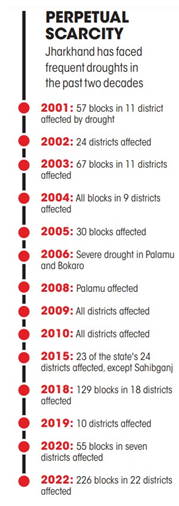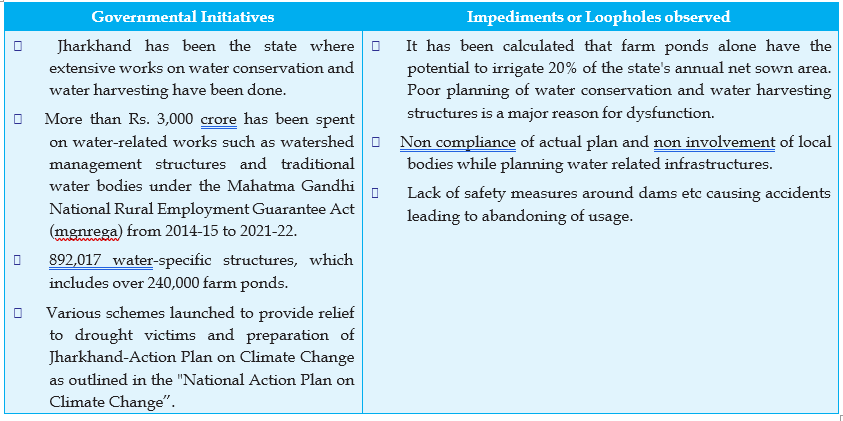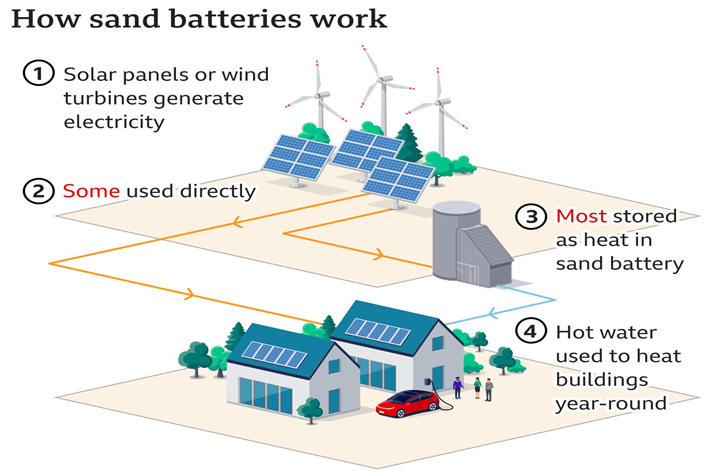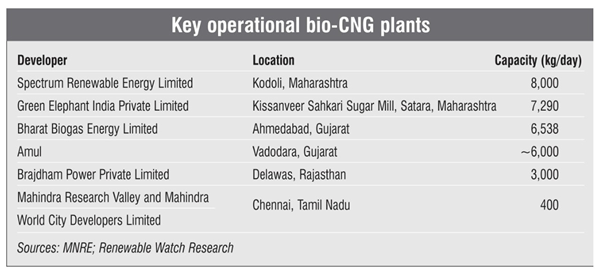Down To Earth(february16-28 2023)
1. DROUGHT PROBLEM IN JHARKHAND
- Despite spending crores of rupees on water conservation and drought management, Jharkhand still lacks drought readiness. According to “Yearly Weather Report-2022 (Jharkhand)” of the India Meteorological Department (imd), the state received 817.6 mm of rainfall, which is 20 per cent below normal.


Reasons of recurring drought:
- 92% of the state's sown area is rainfed and 82 per cent of the annual rainfall is received during monsoon only.
- Changing climate is one of the key factors behind frequent and severe droughts.
- The drying and vanishing water bodies due to improper management and poor planning.
Impact of Droughts:
- Drought is causing farmer distress as farmers in many areas do not have money to buy seeds to sow paddy in the kharif season.
- The loss of soil moisture is causing the land to degrade. According to Indian Space Research Organisation's Desertification and Land Degradation Atlas of India Jharkhand is the state with highest area under desertification/ land degradation in the country for period 2011-13.
- There is huge out migration of people from villages for better life and livelihood.
Response to Drought problem:

Suggested strategies:
- As suggested by NITI Aayog in 2015 that approximately 70 per cent of the sown area during kharif is covered by rice in the state which mostly remains fallow during rabi. This can be utilized to a great extent by a shift to Direct Seeded Rice, with shorter duration varieties. This would also create opportunities to grow crops like short- duration oilseeds (rapeseed, mustard, linseed), pulses (gram, lentil, pea) and vegetables.
- With changing climate, the burden of diseases in central India, including Jharkhand is slated to go up thus connecting the communities, involving them in planning and designing of decentralized systems for source sustainability is needed.
2. SAND BATTERIES: ROUND THE YEAR AVAILABILITY OF CLEAN ENERGY
- The world's first sand battery that can store heat from renewable energy sources for months. The battery, made of sand collected from construction sites, can solve the problem of round-the year energy supply. The battery is installed in Finland's Kankaanpää town developed by Polar Night Energy.

How does it work?


- The installed battery can store 8 megawatt-hours (MWh) of energy and release heat at 0.1 MW when fully charged.
Limitations of the technology:
- The storage system requires electricity at all times.
- The technology is promising but its current capacity is not enough to meet the heating needs of an entire season.
- It is not reasonable to make an entire town to rely on just one storage system.
- Compressed Biogas, also called bio-compressed natural gas or bio-cng is a fuel with calorific value similar to that of CNG which can replace the fossil fuel for which India largely depends on imports. Bio-cng can also be the solution to the country's air pollution problem.
What is Bio-CNG?
- It is an advanced version of biogas produced from animal manure and food waste.
- Biogas is a mixture of different gasses produced by the breakdown of agricultural waste, manure, municipal waste, plant material, sewage, green waste, or food waste, in the absence of oxygen.
- When this mixture is further purified and processed, it is called bio-compressed natural gas (bio-CNG).

Bio-CNG in India:
- The 2022-23 budget announced the setting up of 200 bio-cng plants in the country. The proposed bio-cng plants, 75 of which will be in urban areas, are part of the gobardhan (Galvanizing Organic Bio-Agro Resources Dhan) scheme under the Union Ministry of Drinking Water and Sanitation.
- The country began to seriously explore Bio-CNG in June 2018 with the announcement of the National Policy on Biofuels.
- The Union Ministry of Petroleum and Natural Gas rolled out Sustainable Alternative Towards Affordable Transportation or SATAT scheme with a target of setting up 5,000 bio-cng plants by 2023-24 of which 40 bio-cng plants are operational so far.

- India's installed capacity of bio-cng stands at 311 tonnes, against the potential of 62 million tonnes a year.
- It is a decentralized clean energy form that can be produced at the point of consumption, throughout the year and at all times of the day.
Impediments in growth of Bio-CNG:
- SATAT only guarantees a buyer for the fuel, but the entire onus of setting up the plant, procuring quality feedstock and manufacturing rests exclusively on owners of the plant.
- High cost of setting up of Bio-CNG plant.
- The total budget outlay for the central financial assistance is Rs. 600 crore, which industry players say is not
- enough to install 5,000 plants.
- Biggest operational challenge is ensuring quality feedstock since is waste is not segregated properly from the source.
Way Forward:
- The Union government could initiate an umbrella scheme to offtake, upgrade, build and market bio fertilizer/
- organic fertilizer obtained from the biogas plant.
- The recent budget has reiterated the country's commitment to bio-cng. It now needs to create a healthy ecosystem with easy feedstock availability and uptake of the gas.
4. INVASIVE SPECIES IN CORAL BEACH
- Tamil Nadu had identified land in Ramanathapuram and Pudukottai to set up a 128 crore seaweed park. Experts point to the threat that Kappaphycus, a widely grown invasive seaweed, poses to corals in the Gulf of Mannar Marine National Park running along the state's coastline.
|
Behind story:
- Kappaphycus is a seaweed whose commercial production began in the 1960's in the Philippines where it is a native species.

- This seaweed spread from Hawaii Institute of Marine Biology to Coconut Island in Hawaii, Cubagua Island in Venezuela, Zanzibar in Tanzania, and Almirante and Cristobal in Panama, Costa Rica and India.
- PepsiCo introduced it to the northern part of the Gulf of Mannar Marine National Park without a proper environmental impact assessment.
- In 2005, the Tamil Nadu government prohibited cultivation of the species in sea waters between the north of Palk Bay and south of Tuticorin district yet the seaweed has been seen at various beaches since.

Problems due to Kappaphycus:
- Kappaphycus is associated with the phenomenon of bio invasion. Biological invasions take place when species are deliberately or accidentally introduced and become established in environments that they have not previously occupied.
- The two sites in Kurusadai island were studied and found that Kappaphycus had successfully established itself on corals.
- The alga forms a thick green mat, cutting off the coral's ability to make food.
- It was smothering (suffocating) the corals.
Efforts made and way forward:
- In 2008, field studies were conducted to study the spread of invasive species.
- The forest department of Tamil Nadu manually removed the alga within a 500 sq m area of Kurusadai.
- The 2021 survey suggests that the Tamil Nadu government takes appropriate policy decisions by not permitting cultivation of invasive exotic seaweed in and around coral reefs. Instead, it recommends cultivation of native seaweed.
- Schemes like the Pradhan Mantri Matsya Sampada Yojana could help farmers make a smooth transition from harmful seaweed cultivation to sustainable practices.
5. PROTECTIONISM IN FACE OF CLIMATE CHANGE INITIATIVES
- Various countries especially developed countries like the US, EU etc have taken steps for speedy transition to Green Energy. It appears to be a welcome step but these have given rise to protectionism to boost the renewable energy sector for market capture. it has sparked fears of economic rivalry and neo-pro-tectionism.
|
Special and Differential Treatment” by WTO:
- The World Trade Organization (WTO) tried to reduce trade barriers and encourage countries to treat one another's products equally to boost global commerce and to bring about stability of the global economy.
- In the 1990s, the rich world found that it would be cheaper for its industries to set up units in countries like in China for easy labor availability, less labor regulations and environmental safeguards that could be ignored. As a result, the rich world “exported” their emissions to other countries and continued to consume goods at cheaper rates, while not reducing their domestic emissions.
- As per the sixth IPCC report governments have two policy instruments:
- Market-based policy like carbon taxes which can make polluting industrial activities more expensive, or emissions trading systems that can reward entities that pollute less while making bigger polluters pay.
- Industrial policy that refers to government intervention like subsidies, public procurement, product specific
- research and development and feed in tariffs in strategic economic sectors.
- Experts suggest deploying industrial policy, which can also create jobs and political support for the further growth of the green industry. It could help countries like India to diversify their products and trade.
- But since its inception, WTO has treated industrial policies like subsidies and export bans as “trade-distorting”.
- Thus experts have recognised a trend within WTO to prevent developing countries from deploying industrial
- policy tools to achieve economic diversification and industrialisation.
- Yet developed countries use multilateral institutions like WTO to make policies and decisions which allow them to take lead in new sectors like renewable energy. Eg: US's IRA.
Impact on India:
- Since the US and EU are among the top destinations for Indian exports, these laws will certainly have an impact on Indian businesses.
- Impact of Carbon Border Adjustment Mechanism (CBAM):
- Indian Steel, aluminum and iron are major exported items from India which are inside the purview of CBAM.
- Currently it is difficult to gauge the impact of CBAM on India as India does not have a single domestic carbon
- price.
- CBAM favors large industry players that can afford the capital expenditure on new green technologies and machinery, an advantage that smaller players usually lack.
- Though India has initially joined other countries to voice its concerns against CBAM, it would be undesirable for India to seek a dispute with the EU at the WTO on it since it has diverse trade with the EU.
- India could also seek partnerships with the EU to become a production hub for green technologies emerging from the EU.

Way Forward:
- It would also be risky for India to lead a campaign against these laws by developed countries since it has its own domestic manufacturing aspirations for green technologies.
- Since prices of minerals on the global market are set by big players, India must remain cautious about it being moved out of the market while price setting.
- Better research and development in green technologies in the US or EU through their domestic climate investments
- could benefit countries like India.
- India's current position as leader of the Group of 20 economies (G20) could be a vital opportunity to foster solidarity with the rest of the Global South and argue for a more equitable trade regime amid the climate crisis.
Mains Questions
- Highlight the factors responsible for droughts in India. Suggest measures to mitigate the impact of droughts.
- The process of desertification does not have climate boundaries. Justify with examples. (2020)
- In what way micro-watershed development projects help in water conservation in drought-prone and semi-arid regions of India? (2016)
QUICK LINKS